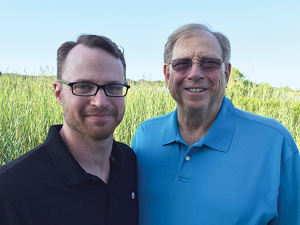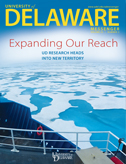

ALUMNI & FRIENDS | When Eugene Cain, EG32, graduated from the University of Delaware with an electrical engineering degree during the height of the Great Depression, close to 15 million people in the United States were unemployed.
One skill saved Cain from joining their ranks—baseball. A power company—the one he would work for his whole life— hired him as a stevedore so he could join the semi-pro team they sponsored.
By the time his son, Donald, EG68, enrolled at UD more than 30 years later, the economy had turned around, and the second electrical engineer in the family also found work in the power industry, where he spent his entire career designing lines and hooking up customers.
Don’s son Bradley, EG95, 97M, followed in his family’s footsteps, joining the power industry as an “engineer turned manager,” before venturing off to design Internet data center products for a series of startups.
The world of computing
Both Don and Brad Cain learned from the “giants” of the department. Don worked with early computer expert Dave Robinson, and Brad worked on several projects with Internet pioneer David Mills, who became his graduate school adviser.
In Eugene Cain’s time at UD, computers hadn’t yet been invented. By the time Don arrived at the University, one of the first commercially viable computers, the PDP8, was available, but the Internet wasn’t even a concept yet. Don worked with Robinson on the PDP8, and Brad then went on to help develop protocols for the emerging Internet.
“When I graduated, I started working in this area immediately because there were very few people coming out of college with my level of knowledge at that time,” Brad Cain says. “My success was due largely to what Professor Mills had taught me and the connections he made for me.”
Neither of the younger Cains felt pressured to follow in their respective fathers’ footsteps but rather viewed them as role models.
“Whenever there was a storm and the power was out, my father had to work,” Don says. “He could fix anything, and he could make anything work. That fascinated me.”
Brad recalls growing up in the 1980s, when personal computers were starting to become commonplace. “I was hooked from the age of 10,” he says. “When it came time to choose a major, I was actually torn between electrical engineering and computer science. Engineering turned out to be a good choice because although I work primarily on the software side, my background enables me to interface effectively with the hardware folks.”
Ken Barner, professor and chair of UD’s Department of Electrical and Computer Engineering, notes that the Cain family has spanned a period of tremendous change in the fields of electrical and computer engineering since the 1920s.
“The discipline has followed a phenomenal arc and continues to impact society in tremendous ways,” he says. “You can see that from the changes that the three members of this family have observed and contributed to.”
The next generation
While the Cains represent multiple generations of Blue Hen electrical engineers, Brad isn’t sure whether the next generation will yield another. His sons, Matthew, 6, and Ryan, 4, are still a bit young to be choosing careers.
But Brad has no doubt he made the right choice.
“The creative aspect of building something to solve a problem is the coolest part of being an engineer,” he says. “Even though my grandfather, my father and I followed different paths with the same degree, we were all part of building an infrastructure and making things work behind the scenes.”
Article by Diane Kukich, AS73, 84M


